Electrical Machines: Core Types, Applications, and Efficiency
VerifiedAdded on 2020/10/05
|10
|2335
|370
Report
AI Summary
This report provides a comprehensive overview of electrical machines, encompassing transformers, induction and synchronous motors, and generators. The report delves into the core types of transformers, their applications, and the main connections of three-phase transformers, including calculations of equivalent resistance, reactance, and efficiency. It further explores the operational characteristics, starting methods, and industrial applications of induction and synchronous motors, along with generator types, constructions, and efficiency calculations. Additionally, the report examines magnetic actuators and transducers, their types, operations, and selection for industrial applications. The conclusion summarizes the key concepts and practical applications discussed throughout the report, emphasizing the importance of understanding electrical machines in various engineering contexts. The report references several books and journals, providing a robust foundation for the analysis presented.
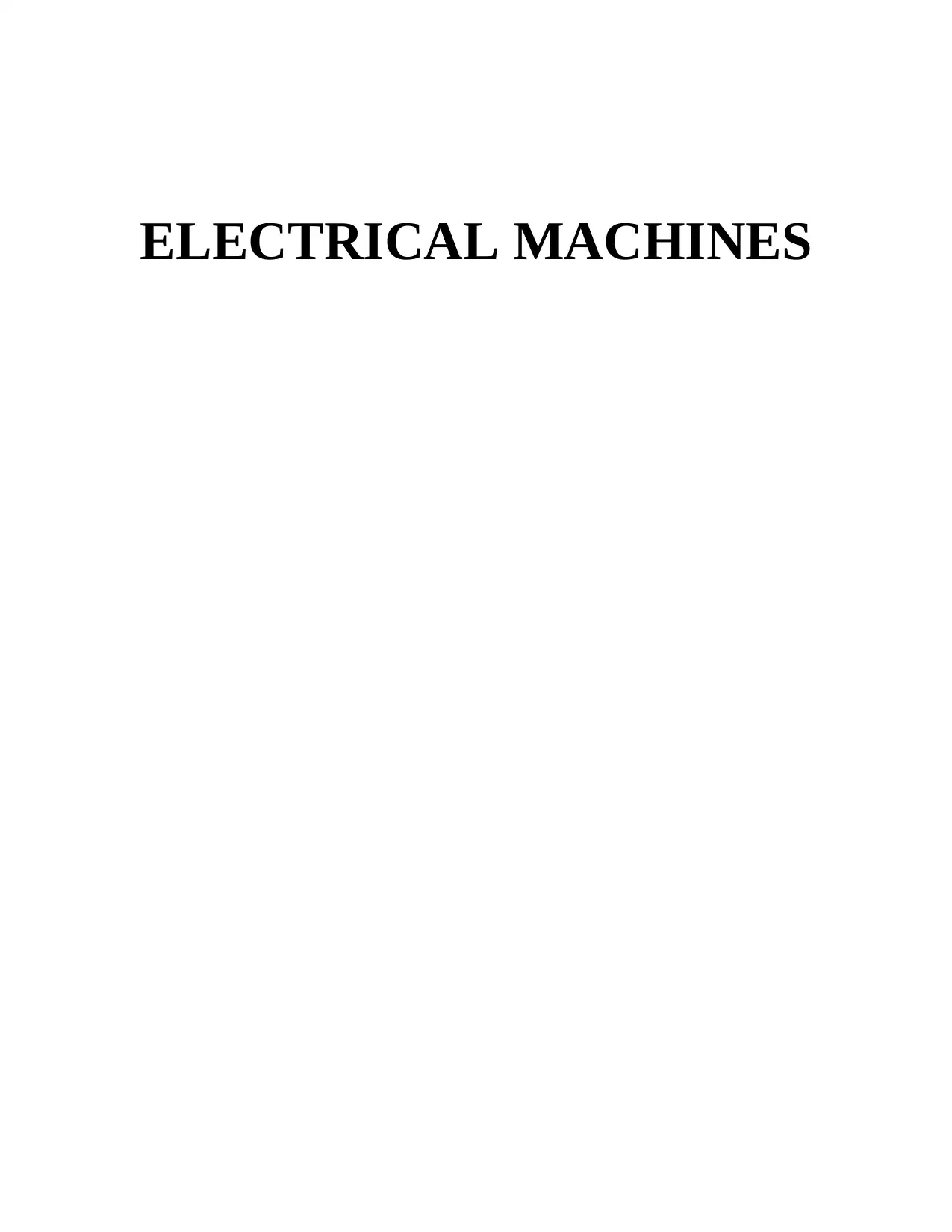
ELECTRICAL MACHINES
Paraphrase This Document
Need a fresh take? Get an instant paraphrase of this document with our AI Paraphraser
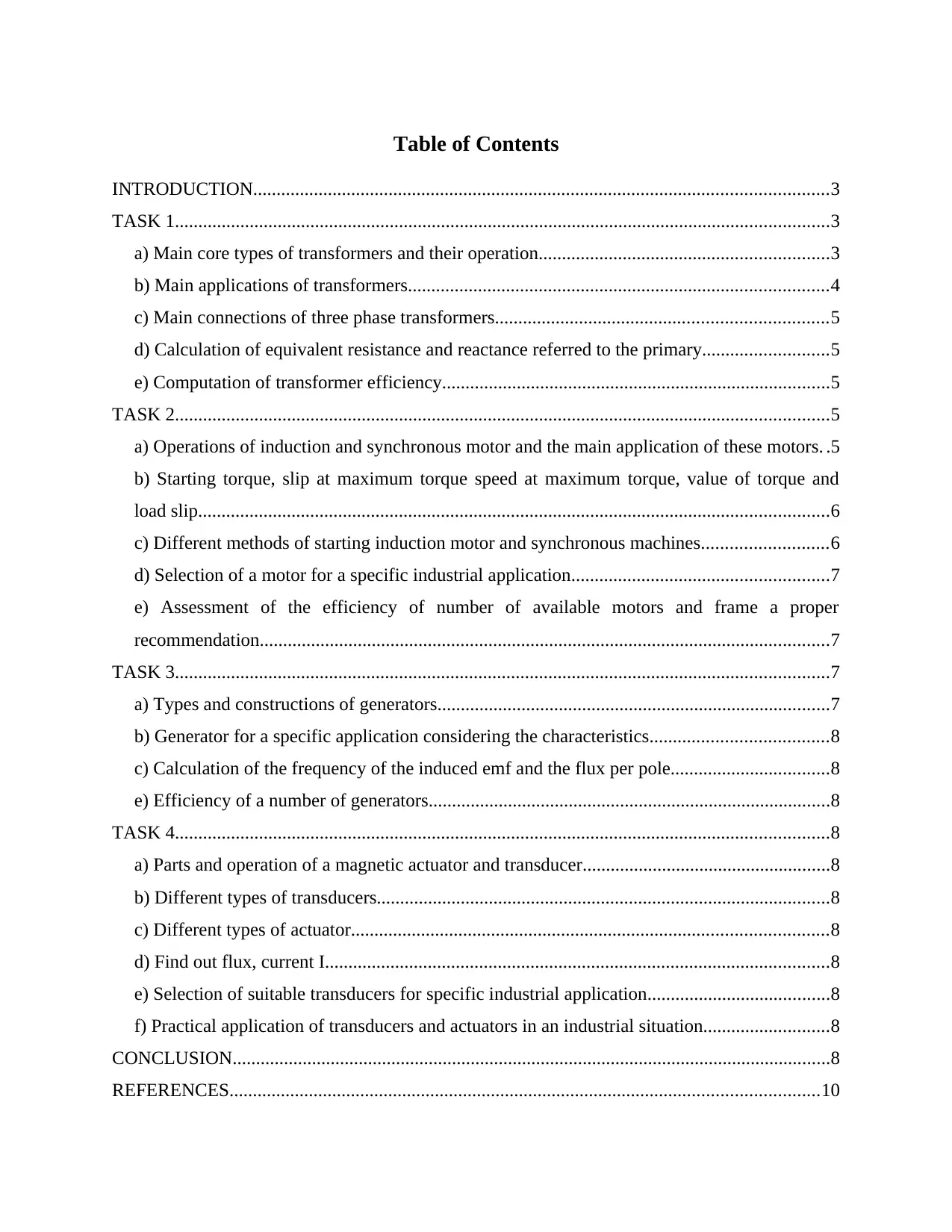
Table of Contents
INTRODUCTION...........................................................................................................................3
TASK 1............................................................................................................................................3
a) Main core types of transformers and their operation..............................................................3
b) Main applications of transformers..........................................................................................4
c) Main connections of three phase transformers.......................................................................5
d) Calculation of equivalent resistance and reactance referred to the primary...........................5
e) Computation of transformer efficiency...................................................................................5
TASK 2............................................................................................................................................5
a) Operations of induction and synchronous motor and the main application of these motors. .5
b) Starting torque, slip at maximum torque speed at maximum torque, value of torque and
load slip.......................................................................................................................................6
c) Different methods of starting induction motor and synchronous machines...........................6
d) Selection of a motor for a specific industrial application.......................................................7
e) Assessment of the efficiency of number of available motors and frame a proper
recommendation..........................................................................................................................7
TASK 3............................................................................................................................................7
a) Types and constructions of generators....................................................................................7
b) Generator for a specific application considering the characteristics......................................8
c) Calculation of the frequency of the induced emf and the flux per pole..................................8
e) Efficiency of a number of generators......................................................................................8
TASK 4............................................................................................................................................8
a) Parts and operation of a magnetic actuator and transducer.....................................................8
b) Different types of transducers.................................................................................................8
c) Different types of actuator......................................................................................................8
d) Find out flux, current I............................................................................................................8
e) Selection of suitable transducers for specific industrial application.......................................8
f) Practical application of transducers and actuators in an industrial situation...........................8
CONCLUSION................................................................................................................................8
REFERENCES..............................................................................................................................10
INTRODUCTION...........................................................................................................................3
TASK 1............................................................................................................................................3
a) Main core types of transformers and their operation..............................................................3
b) Main applications of transformers..........................................................................................4
c) Main connections of three phase transformers.......................................................................5
d) Calculation of equivalent resistance and reactance referred to the primary...........................5
e) Computation of transformer efficiency...................................................................................5
TASK 2............................................................................................................................................5
a) Operations of induction and synchronous motor and the main application of these motors. .5
b) Starting torque, slip at maximum torque speed at maximum torque, value of torque and
load slip.......................................................................................................................................6
c) Different methods of starting induction motor and synchronous machines...........................6
d) Selection of a motor for a specific industrial application.......................................................7
e) Assessment of the efficiency of number of available motors and frame a proper
recommendation..........................................................................................................................7
TASK 3............................................................................................................................................7
a) Types and constructions of generators....................................................................................7
b) Generator for a specific application considering the characteristics......................................8
c) Calculation of the frequency of the induced emf and the flux per pole..................................8
e) Efficiency of a number of generators......................................................................................8
TASK 4............................................................................................................................................8
a) Parts and operation of a magnetic actuator and transducer.....................................................8
b) Different types of transducers.................................................................................................8
c) Different types of actuator......................................................................................................8
d) Find out flux, current I............................................................................................................8
e) Selection of suitable transducers for specific industrial application.......................................8
f) Practical application of transducers and actuators in an industrial situation...........................8
CONCLUSION................................................................................................................................8
REFERENCES..............................................................................................................................10
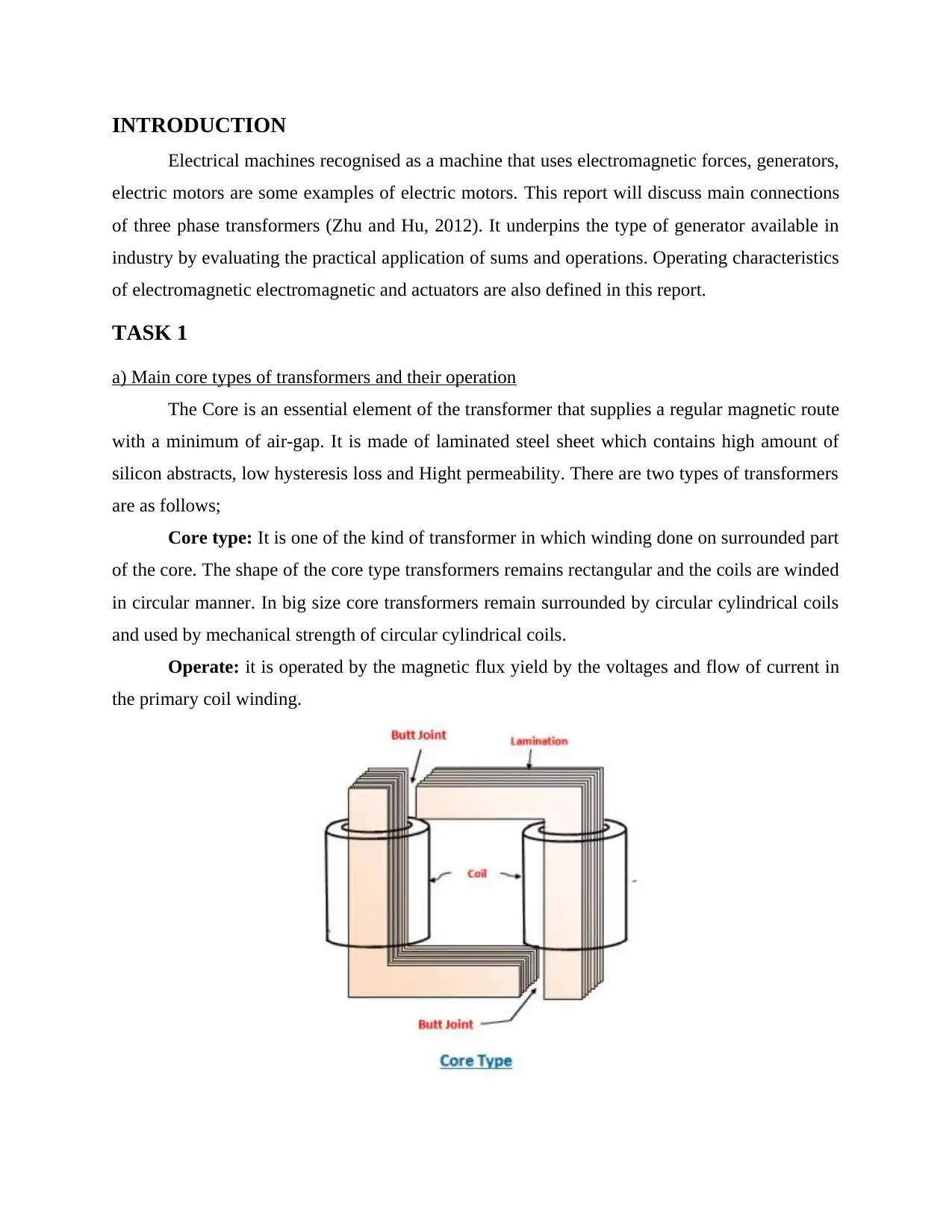
INTRODUCTION
Electrical machines recognised as a machine that uses electromagnetic forces, generators,
electric motors are some examples of electric motors. This report will discuss main connections
of three phase transformers (Zhu and Hu, 2012). It underpins the type of generator available in
industry by evaluating the practical application of sums and operations. Operating characteristics
of electromagnetic electromagnetic and actuators are also defined in this report.
TASK 1
a) Main core types of transformers and their operation
The Core is an essential element of the transformer that supplies a regular magnetic route
with a minimum of air-gap. It is made of laminated steel sheet which contains high amount of
silicon abstracts, low hysteresis loss and Hight permeability. There are two types of transformers
are as follows;
Core type: It is one of the kind of transformer in which winding done on surrounded part
of the core. The shape of the core type transformers remains rectangular and the coils are winded
in circular manner. In big size core transformers remain surrounded by circular cylindrical coils
and used by mechanical strength of circular cylindrical coils.
Operate: it is operated by the magnetic flux yield by the voltages and flow of current in
the primary coil winding.
Electrical machines recognised as a machine that uses electromagnetic forces, generators,
electric motors are some examples of electric motors. This report will discuss main connections
of three phase transformers (Zhu and Hu, 2012). It underpins the type of generator available in
industry by evaluating the practical application of sums and operations. Operating characteristics
of electromagnetic electromagnetic and actuators are also defined in this report.
TASK 1
a) Main core types of transformers and their operation
The Core is an essential element of the transformer that supplies a regular magnetic route
with a minimum of air-gap. It is made of laminated steel sheet which contains high amount of
silicon abstracts, low hysteresis loss and Hight permeability. There are two types of transformers
are as follows;
Core type: It is one of the kind of transformer in which winding done on surrounded part
of the core. The shape of the core type transformers remains rectangular and the coils are winded
in circular manner. In big size core transformers remain surrounded by circular cylindrical coils
and used by mechanical strength of circular cylindrical coils.
Operate: it is operated by the magnetic flux yield by the voltages and flow of current in
the primary coil winding.
⊘ This is a preview!⊘
Do you want full access?
Subscribe today to unlock all pages.

Trusted by 1+ million students worldwide
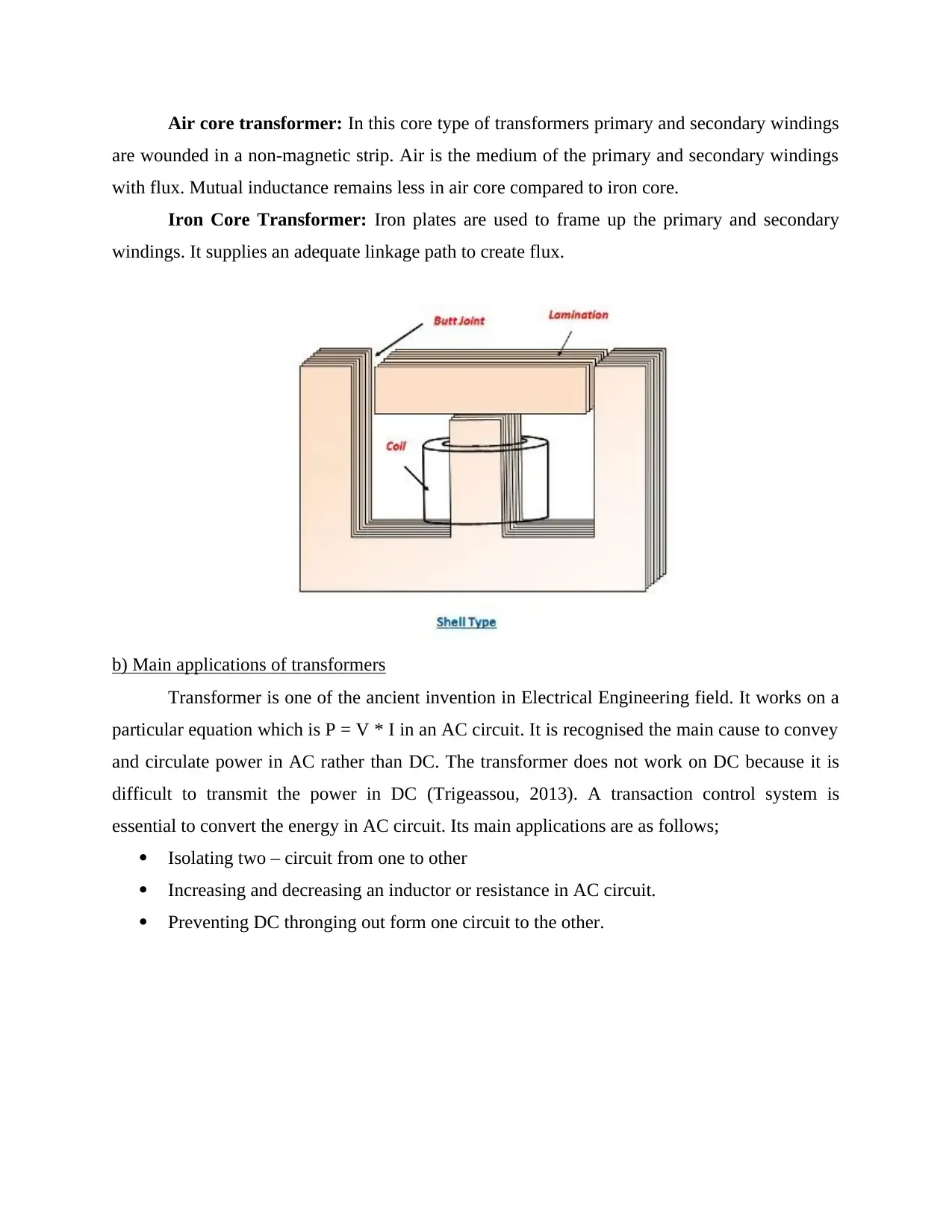
Air core transformer: In this core type of transformers primary and secondary windings
are wounded in a non-magnetic strip. Air is the medium of the primary and secondary windings
with flux. Mutual inductance remains less in air core compared to iron core.
Iron Core Transformer: Iron plates are used to frame up the primary and secondary
windings. It supplies an adequate linkage path to create flux.
b) Main applications of transformers
Transformer is one of the ancient invention in Electrical Engineering field. It works on a
particular equation which is P = V * I in an AC circuit. It is recognised the main cause to convey
and circulate power in AC rather than DC. The transformer does not work on DC because it is
difficult to transmit the power in DC (Trigeassou, 2013). A transaction control system is
essential to convert the energy in AC circuit. Its main applications are as follows;
Isolating two – circuit from one to other
Increasing and decreasing an inductor or resistance in AC circuit.
Preventing DC thronging out form one circuit to the other.
are wounded in a non-magnetic strip. Air is the medium of the primary and secondary windings
with flux. Mutual inductance remains less in air core compared to iron core.
Iron Core Transformer: Iron plates are used to frame up the primary and secondary
windings. It supplies an adequate linkage path to create flux.
b) Main applications of transformers
Transformer is one of the ancient invention in Electrical Engineering field. It works on a
particular equation which is P = V * I in an AC circuit. It is recognised the main cause to convey
and circulate power in AC rather than DC. The transformer does not work on DC because it is
difficult to transmit the power in DC (Trigeassou, 2013). A transaction control system is
essential to convert the energy in AC circuit. Its main applications are as follows;
Isolating two – circuit from one to other
Increasing and decreasing an inductor or resistance in AC circuit.
Preventing DC thronging out form one circuit to the other.
Paraphrase This Document
Need a fresh take? Get an instant paraphrase of this document with our AI Paraphraser
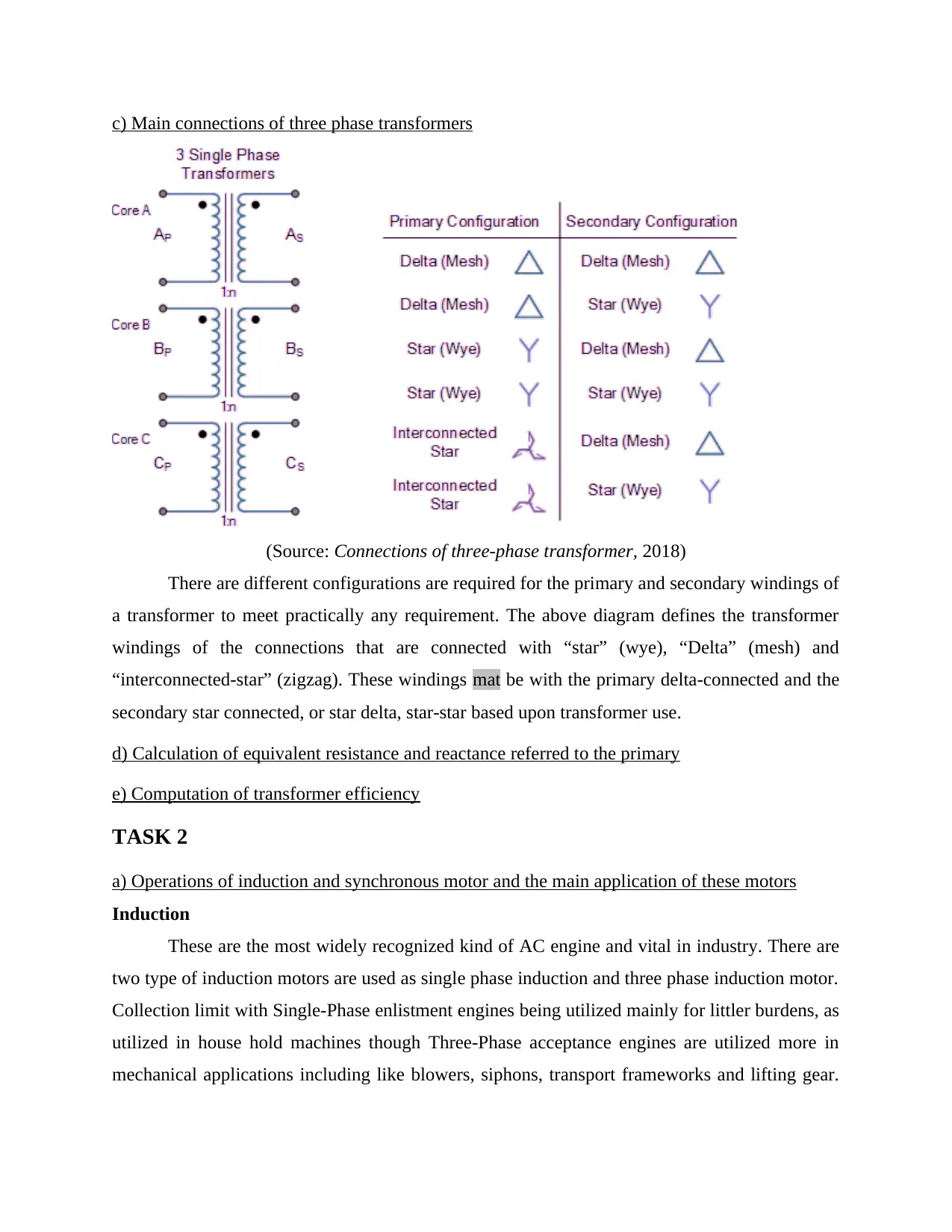
c) Main connections of three phase transformers
(Source: Connections of three-phase transformer, 2018)
There are different configurations are required for the primary and secondary windings of
a transformer to meet practically any requirement. The above diagram defines the transformer
windings of the connections that are connected with “star” (wye), “Delta” (mesh) and
“interconnected-star” (zigzag). These windings mat be with the primary delta-connected and the
secondary star connected, or star delta, star-star based upon transformer use.
d) Calculation of equivalent resistance and reactance referred to the primary
e) Computation of transformer efficiency
TASK 2
a) Operations of induction and synchronous motor and the main application of these motors
Induction
These are the most widely recognized kind of AC engine and vital in industry. There are
two type of induction motors are used as single phase induction and three phase induction motor.
Collection limit with Single-Phase enlistment engines being utilized mainly for littler burdens, as
utilized in house hold machines though Three-Phase acceptance engines are utilized more in
mechanical applications including like blowers, siphons, transport frameworks and lifting gear.
(Source: Connections of three-phase transformer, 2018)
There are different configurations are required for the primary and secondary windings of
a transformer to meet practically any requirement. The above diagram defines the transformer
windings of the connections that are connected with “star” (wye), “Delta” (mesh) and
“interconnected-star” (zigzag). These windings mat be with the primary delta-connected and the
secondary star connected, or star delta, star-star based upon transformer use.
d) Calculation of equivalent resistance and reactance referred to the primary
e) Computation of transformer efficiency
TASK 2
a) Operations of induction and synchronous motor and the main application of these motors
Induction
These are the most widely recognized kind of AC engine and vital in industry. There are
two type of induction motors are used as single phase induction and three phase induction motor.
Collection limit with Single-Phase enlistment engines being utilized mainly for littler burdens, as
utilized in house hold machines though Three-Phase acceptance engines are utilized more in
mechanical applications including like blowers, siphons, transport frameworks and lifting gear.
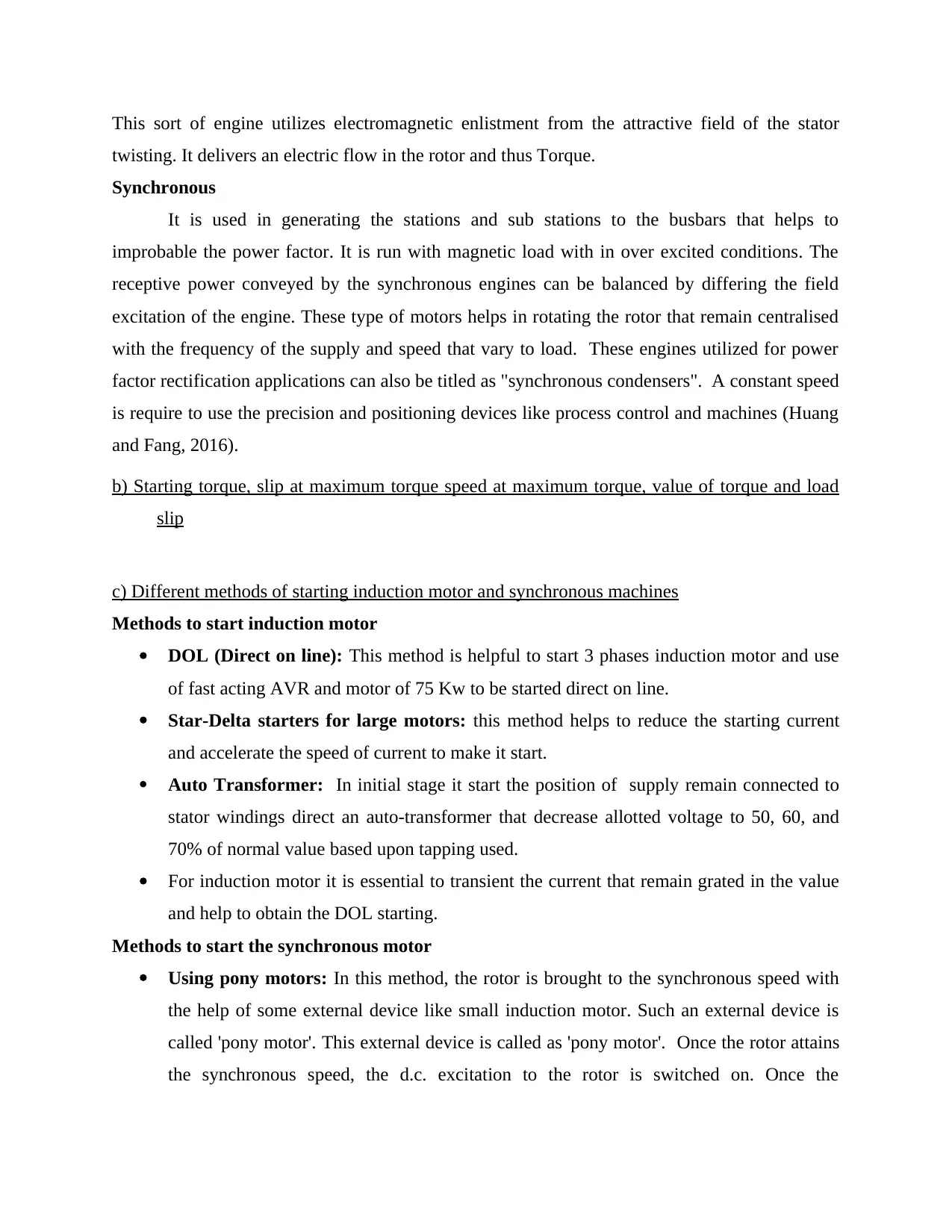
This sort of engine utilizes electromagnetic enlistment from the attractive field of the stator
twisting. It delivers an electric flow in the rotor and thus Torque.
Synchronous
It is used in generating the stations and sub stations to the busbars that helps to
improbable the power factor. It is run with magnetic load with in over excited conditions. The
receptive power conveyed by the synchronous engines can be balanced by differing the field
excitation of the engine. These type of motors helps in rotating the rotor that remain centralised
with the frequency of the supply and speed that vary to load. These engines utilized for power
factor rectification applications can also be titled as "synchronous condensers". A constant speed
is require to use the precision and positioning devices like process control and machines (Huang
and Fang, 2016).
b) Starting torque, slip at maximum torque speed at maximum torque, value of torque and load
slip
c) Different methods of starting induction motor and synchronous machines
Methods to start induction motor
DOL (Direct on line): This method is helpful to start 3 phases induction motor and use
of fast acting AVR and motor of 75 Kw to be started direct on line.
Star-Delta starters for large motors: this method helps to reduce the starting current
and accelerate the speed of current to make it start.
Auto Transformer: In initial stage it start the position of supply remain connected to
stator windings direct an auto-transformer that decrease allotted voltage to 50, 60, and
70% of normal value based upon tapping used.
For induction motor it is essential to transient the current that remain grated in the value
and help to obtain the DOL starting.
Methods to start the synchronous motor
Using pony motors: In this method, the rotor is brought to the synchronous speed with
the help of some external device like small induction motor. Such an external device is
called 'pony motor'. This external device is called as 'pony motor'. Once the rotor attains
the synchronous speed, the d.c. excitation to the rotor is switched on. Once the
twisting. It delivers an electric flow in the rotor and thus Torque.
Synchronous
It is used in generating the stations and sub stations to the busbars that helps to
improbable the power factor. It is run with magnetic load with in over excited conditions. The
receptive power conveyed by the synchronous engines can be balanced by differing the field
excitation of the engine. These type of motors helps in rotating the rotor that remain centralised
with the frequency of the supply and speed that vary to load. These engines utilized for power
factor rectification applications can also be titled as "synchronous condensers". A constant speed
is require to use the precision and positioning devices like process control and machines (Huang
and Fang, 2016).
b) Starting torque, slip at maximum torque speed at maximum torque, value of torque and load
slip
c) Different methods of starting induction motor and synchronous machines
Methods to start induction motor
DOL (Direct on line): This method is helpful to start 3 phases induction motor and use
of fast acting AVR and motor of 75 Kw to be started direct on line.
Star-Delta starters for large motors: this method helps to reduce the starting current
and accelerate the speed of current to make it start.
Auto Transformer: In initial stage it start the position of supply remain connected to
stator windings direct an auto-transformer that decrease allotted voltage to 50, 60, and
70% of normal value based upon tapping used.
For induction motor it is essential to transient the current that remain grated in the value
and help to obtain the DOL starting.
Methods to start the synchronous motor
Using pony motors: In this method, the rotor is brought to the synchronous speed with
the help of some external device like small induction motor. Such an external device is
called 'pony motor'. This external device is called as 'pony motor'. Once the rotor attains
the synchronous speed, the d.c. excitation to the rotor is switched on. Once the
⊘ This is a preview!⊘
Do you want full access?
Subscribe today to unlock all pages.

Trusted by 1+ million students worldwide
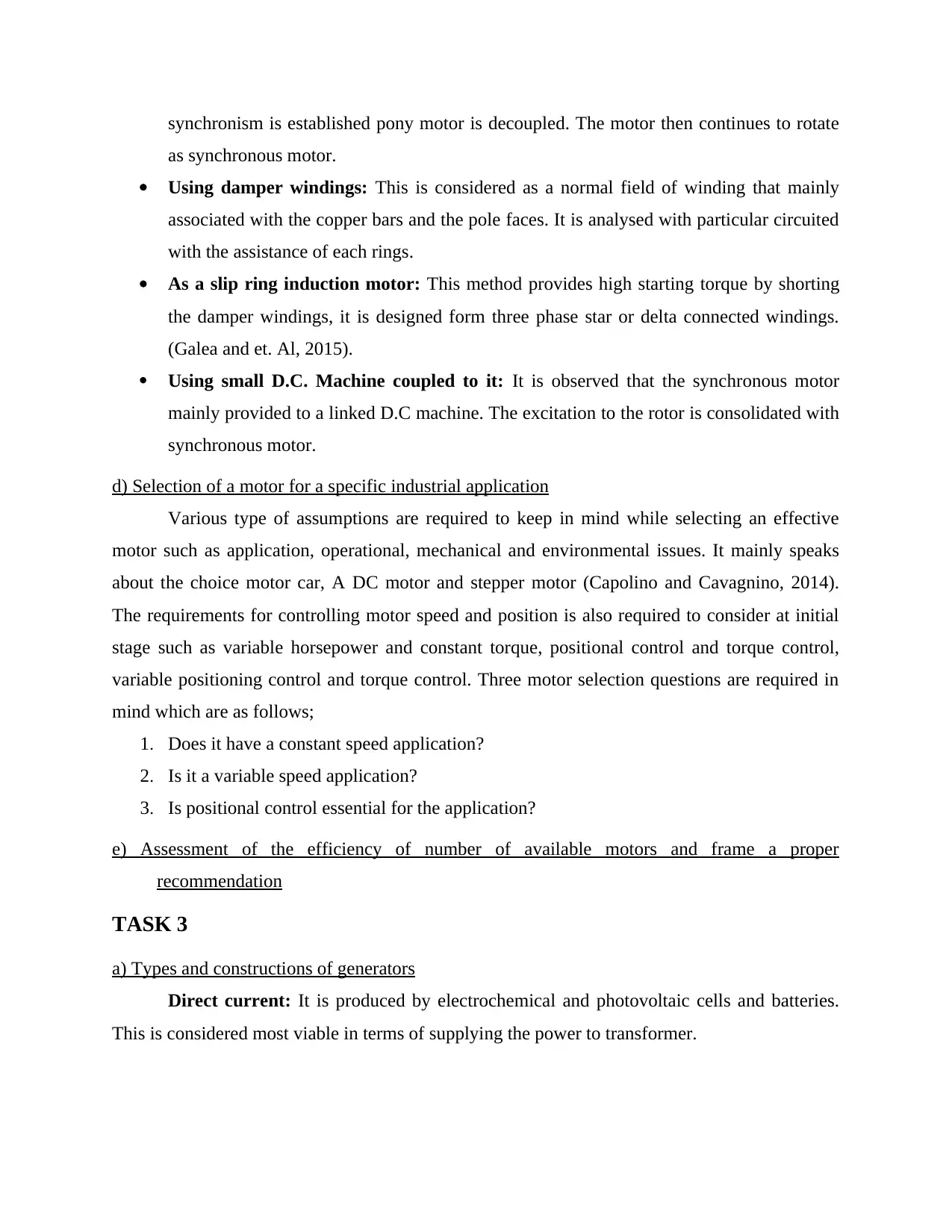
synchronism is established pony motor is decoupled. The motor then continues to rotate
as synchronous motor.
Using damper windings: This is considered as a normal field of winding that mainly
associated with the copper bars and the pole faces. It is analysed with particular circuited
with the assistance of each rings.
As a slip ring induction motor: This method provides high starting torque by shorting
the damper windings, it is designed form three phase star or delta connected windings.
(Galea and et. Al, 2015).
Using small D.C. Machine coupled to it: It is observed that the synchronous motor
mainly provided to a linked D.C machine. The excitation to the rotor is consolidated with
synchronous motor.
d) Selection of a motor for a specific industrial application
Various type of assumptions are required to keep in mind while selecting an effective
motor such as application, operational, mechanical and environmental issues. It mainly speaks
about the choice motor car, A DC motor and stepper motor (Capolino and Cavagnino, 2014).
The requirements for controlling motor speed and position is also required to consider at initial
stage such as variable horsepower and constant torque, positional control and torque control,
variable positioning control and torque control. Three motor selection questions are required in
mind which are as follows;
1. Does it have a constant speed application?
2. Is it a variable speed application?
3. Is positional control essential for the application?
e) Assessment of the efficiency of number of available motors and frame a proper
recommendation
TASK 3
a) Types and constructions of generators
Direct current: It is produced by electrochemical and photovoltaic cells and batteries.
This is considered most viable in terms of supplying the power to transformer.
as synchronous motor.
Using damper windings: This is considered as a normal field of winding that mainly
associated with the copper bars and the pole faces. It is analysed with particular circuited
with the assistance of each rings.
As a slip ring induction motor: This method provides high starting torque by shorting
the damper windings, it is designed form three phase star or delta connected windings.
(Galea and et. Al, 2015).
Using small D.C. Machine coupled to it: It is observed that the synchronous motor
mainly provided to a linked D.C machine. The excitation to the rotor is consolidated with
synchronous motor.
d) Selection of a motor for a specific industrial application
Various type of assumptions are required to keep in mind while selecting an effective
motor such as application, operational, mechanical and environmental issues. It mainly speaks
about the choice motor car, A DC motor and stepper motor (Capolino and Cavagnino, 2014).
The requirements for controlling motor speed and position is also required to consider at initial
stage such as variable horsepower and constant torque, positional control and torque control,
variable positioning control and torque control. Three motor selection questions are required in
mind which are as follows;
1. Does it have a constant speed application?
2. Is it a variable speed application?
3. Is positional control essential for the application?
e) Assessment of the efficiency of number of available motors and frame a proper
recommendation
TASK 3
a) Types and constructions of generators
Direct current: It is produced by electrochemical and photovoltaic cells and batteries.
This is considered most viable in terms of supplying the power to transformer.
Paraphrase This Document
Need a fresh take? Get an instant paraphrase of this document with our AI Paraphraser
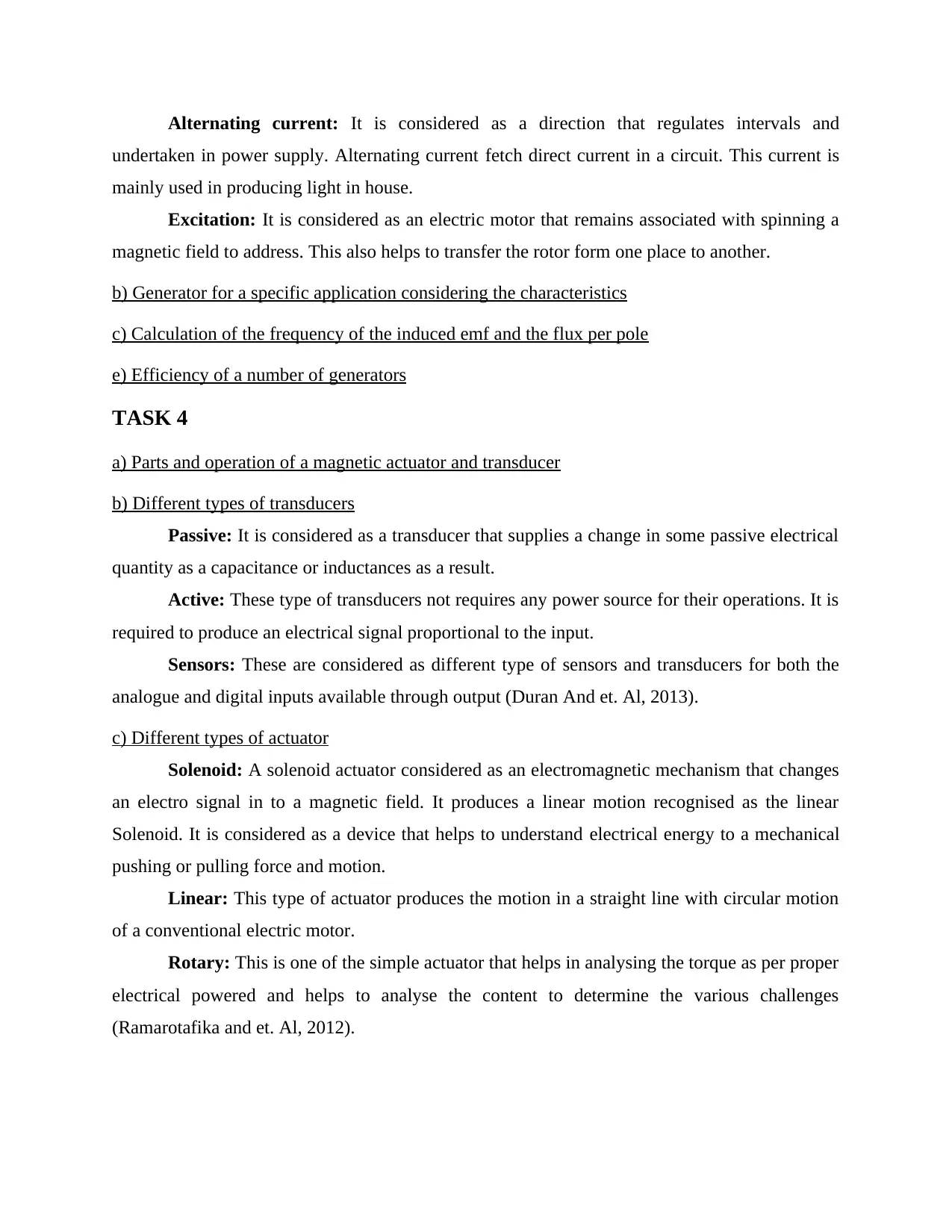
Alternating current: It is considered as a direction that regulates intervals and
undertaken in power supply. Alternating current fetch direct current in a circuit. This current is
mainly used in producing light in house.
Excitation: It is considered as an electric motor that remains associated with spinning a
magnetic field to address. This also helps to transfer the rotor form one place to another.
b) Generator for a specific application considering the characteristics
c) Calculation of the frequency of the induced emf and the flux per pole
e) Efficiency of a number of generators
TASK 4
a) Parts and operation of a magnetic actuator and transducer
b) Different types of transducers
Passive: It is considered as a transducer that supplies a change in some passive electrical
quantity as a capacitance or inductances as a result.
Active: These type of transducers not requires any power source for their operations. It is
required to produce an electrical signal proportional to the input.
Sensors: These are considered as different type of sensors and transducers for both the
analogue and digital inputs available through output (Duran And et. Al, 2013).
c) Different types of actuator
Solenoid: A solenoid actuator considered as an electromagnetic mechanism that changes
an electro signal in to a magnetic field. It produces a linear motion recognised as the linear
Solenoid. It is considered as a device that helps to understand electrical energy to a mechanical
pushing or pulling force and motion.
Linear: This type of actuator produces the motion in a straight line with circular motion
of a conventional electric motor.
Rotary: This is one of the simple actuator that helps in analysing the torque as per proper
electrical powered and helps to analyse the content to determine the various challenges
(Ramarotafika and et. Al, 2012).
undertaken in power supply. Alternating current fetch direct current in a circuit. This current is
mainly used in producing light in house.
Excitation: It is considered as an electric motor that remains associated with spinning a
magnetic field to address. This also helps to transfer the rotor form one place to another.
b) Generator for a specific application considering the characteristics
c) Calculation of the frequency of the induced emf and the flux per pole
e) Efficiency of a number of generators
TASK 4
a) Parts and operation of a magnetic actuator and transducer
b) Different types of transducers
Passive: It is considered as a transducer that supplies a change in some passive electrical
quantity as a capacitance or inductances as a result.
Active: These type of transducers not requires any power source for their operations. It is
required to produce an electrical signal proportional to the input.
Sensors: These are considered as different type of sensors and transducers for both the
analogue and digital inputs available through output (Duran And et. Al, 2013).
c) Different types of actuator
Solenoid: A solenoid actuator considered as an electromagnetic mechanism that changes
an electro signal in to a magnetic field. It produces a linear motion recognised as the linear
Solenoid. It is considered as a device that helps to understand electrical energy to a mechanical
pushing or pulling force and motion.
Linear: This type of actuator produces the motion in a straight line with circular motion
of a conventional electric motor.
Rotary: This is one of the simple actuator that helps in analysing the torque as per proper
electrical powered and helps to analyse the content to determine the various challenges
(Ramarotafika and et. Al, 2012).
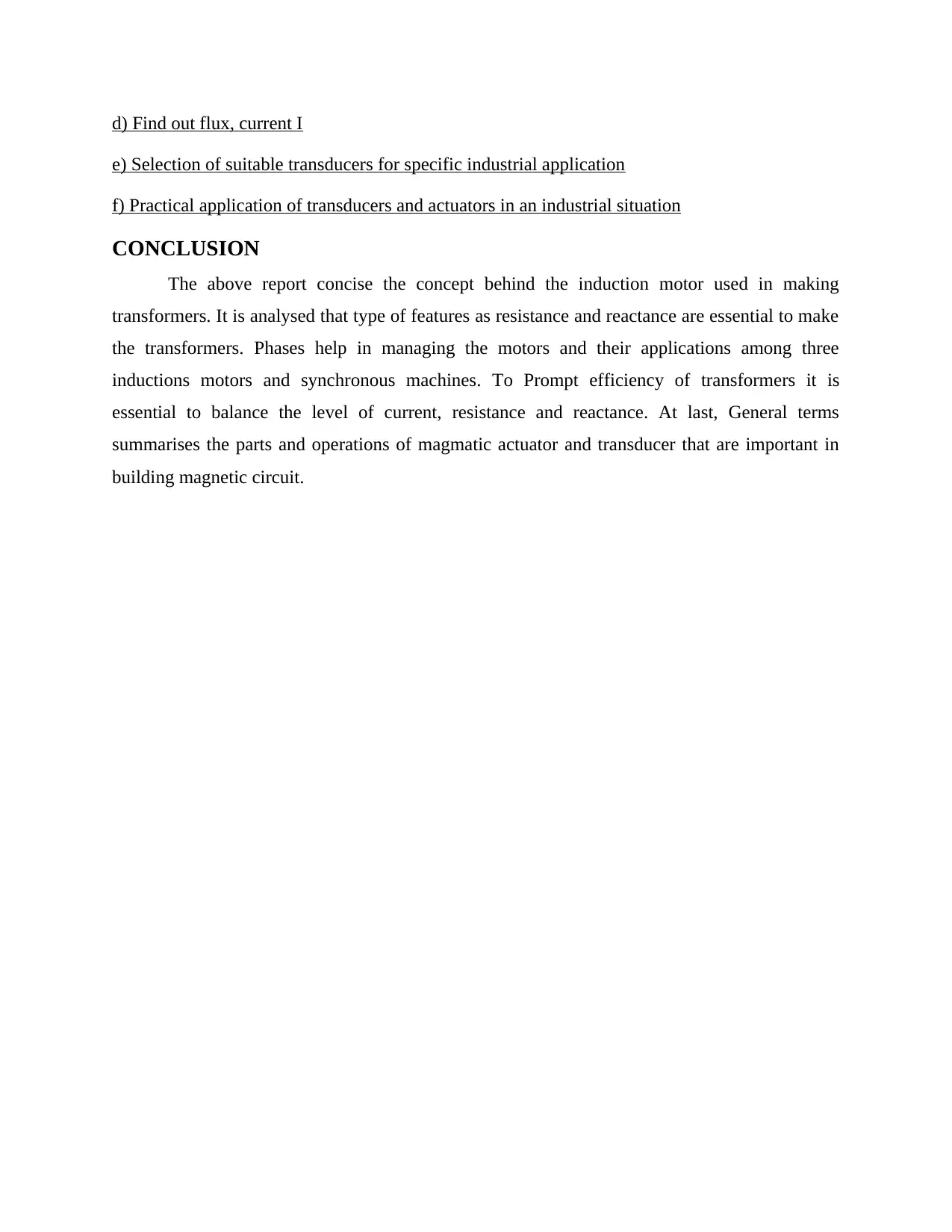
d) Find out flux, current I
e) Selection of suitable transducers for specific industrial application
f) Practical application of transducers and actuators in an industrial situation
CONCLUSION
The above report concise the concept behind the induction motor used in making
transformers. It is analysed that type of features as resistance and reactance are essential to make
the transformers. Phases help in managing the motors and their applications among three
inductions motors and synchronous machines. To Prompt efficiency of transformers it is
essential to balance the level of current, resistance and reactance. At last, General terms
summarises the parts and operations of magmatic actuator and transducer that are important in
building magnetic circuit.
e) Selection of suitable transducers for specific industrial application
f) Practical application of transducers and actuators in an industrial situation
CONCLUSION
The above report concise the concept behind the induction motor used in making
transformers. It is analysed that type of features as resistance and reactance are essential to make
the transformers. Phases help in managing the motors and their applications among three
inductions motors and synchronous machines. To Prompt efficiency of transformers it is
essential to balance the level of current, resistance and reactance. At last, General terms
summarises the parts and operations of magmatic actuator and transducer that are important in
building magnetic circuit.
⊘ This is a preview!⊘
Do you want full access?
Subscribe today to unlock all pages.

Trusted by 1+ million students worldwide
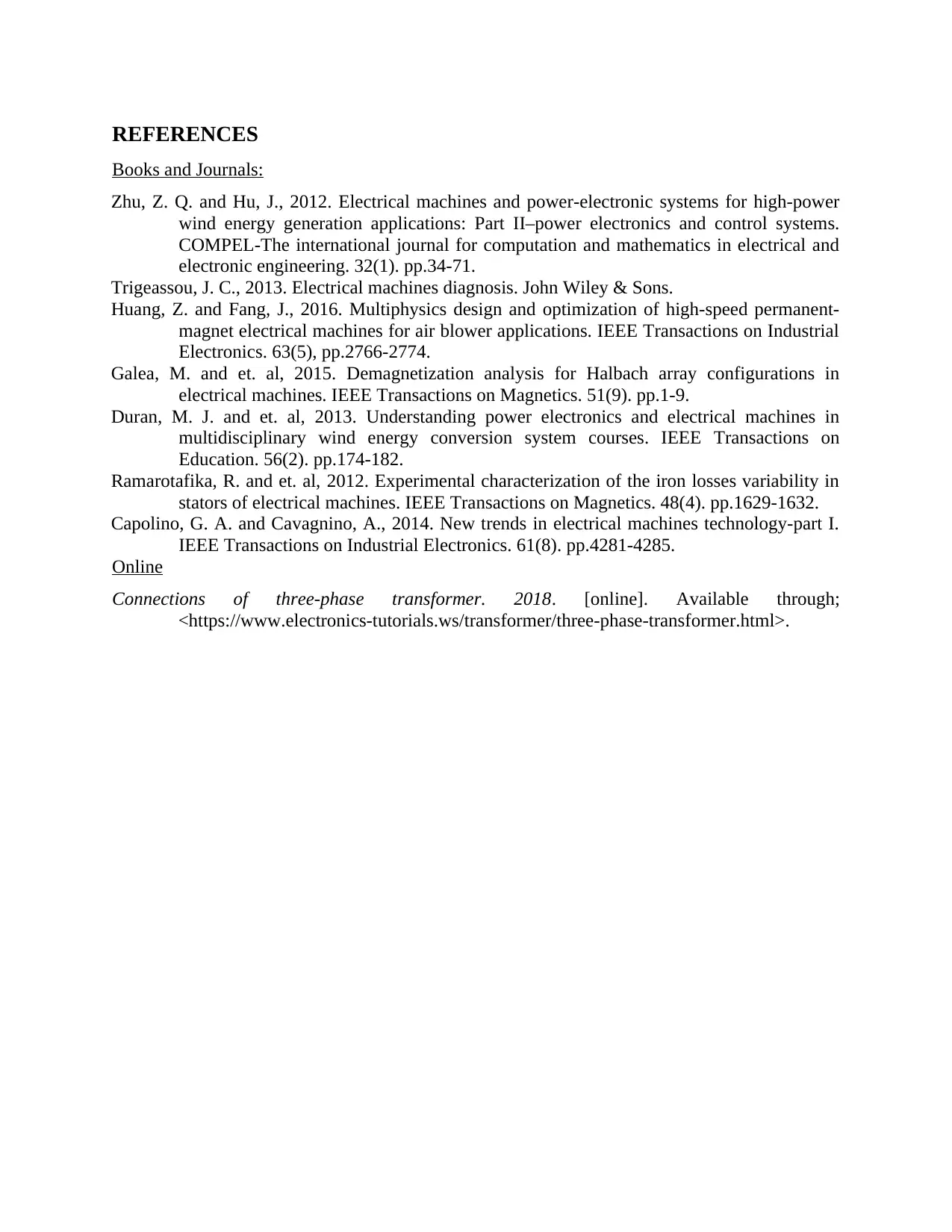
REFERENCES
Books and Journals:
Zhu, Z. Q. and Hu, J., 2012. Electrical machines and power-electronic systems for high-power
wind energy generation applications: Part II–power electronics and control systems.
COMPEL-The international journal for computation and mathematics in electrical and
electronic engineering. 32(1). pp.34-71.
Trigeassou, J. C., 2013. Electrical machines diagnosis. John Wiley & Sons.
Huang, Z. and Fang, J., 2016. Multiphysics design and optimization of high-speed permanent-
magnet electrical machines for air blower applications. IEEE Transactions on Industrial
Electronics. 63(5), pp.2766-2774.
Galea, M. and et. al, 2015. Demagnetization analysis for Halbach array configurations in
electrical machines. IEEE Transactions on Magnetics. 51(9). pp.1-9.
Duran, M. J. and et. al, 2013. Understanding power electronics and electrical machines in
multidisciplinary wind energy conversion system courses. IEEE Transactions on
Education. 56(2). pp.174-182.
Ramarotafika, R. and et. al, 2012. Experimental characterization of the iron losses variability in
stators of electrical machines. IEEE Transactions on Magnetics. 48(4). pp.1629-1632.
Capolino, G. A. and Cavagnino, A., 2014. New trends in electrical machines technology-part I.
IEEE Transactions on Industrial Electronics. 61(8). pp.4281-4285.
Online
Connections of three-phase transformer. 2018. [online]. Available through;
<https://www.electronics-tutorials.ws/transformer/three-phase-transformer.html>.
Books and Journals:
Zhu, Z. Q. and Hu, J., 2012. Electrical machines and power-electronic systems for high-power
wind energy generation applications: Part II–power electronics and control systems.
COMPEL-The international journal for computation and mathematics in electrical and
electronic engineering. 32(1). pp.34-71.
Trigeassou, J. C., 2013. Electrical machines diagnosis. John Wiley & Sons.
Huang, Z. and Fang, J., 2016. Multiphysics design and optimization of high-speed permanent-
magnet electrical machines for air blower applications. IEEE Transactions on Industrial
Electronics. 63(5), pp.2766-2774.
Galea, M. and et. al, 2015. Demagnetization analysis for Halbach array configurations in
electrical machines. IEEE Transactions on Magnetics. 51(9). pp.1-9.
Duran, M. J. and et. al, 2013. Understanding power electronics and electrical machines in
multidisciplinary wind energy conversion system courses. IEEE Transactions on
Education. 56(2). pp.174-182.
Ramarotafika, R. and et. al, 2012. Experimental characterization of the iron losses variability in
stators of electrical machines. IEEE Transactions on Magnetics. 48(4). pp.1629-1632.
Capolino, G. A. and Cavagnino, A., 2014. New trends in electrical machines technology-part I.
IEEE Transactions on Industrial Electronics. 61(8). pp.4281-4285.
Online
Connections of three-phase transformer. 2018. [online]. Available through;
<https://www.electronics-tutorials.ws/transformer/three-phase-transformer.html>.
1 out of 10
Related Documents
Your All-in-One AI-Powered Toolkit for Academic Success.
+13062052269
info@desklib.com
Available 24*7 on WhatsApp / Email
![[object Object]](/_next/static/media/star-bottom.7253800d.svg)
Unlock your academic potential
Copyright © 2020–2025 A2Z Services. All Rights Reserved. Developed and managed by ZUCOL.




